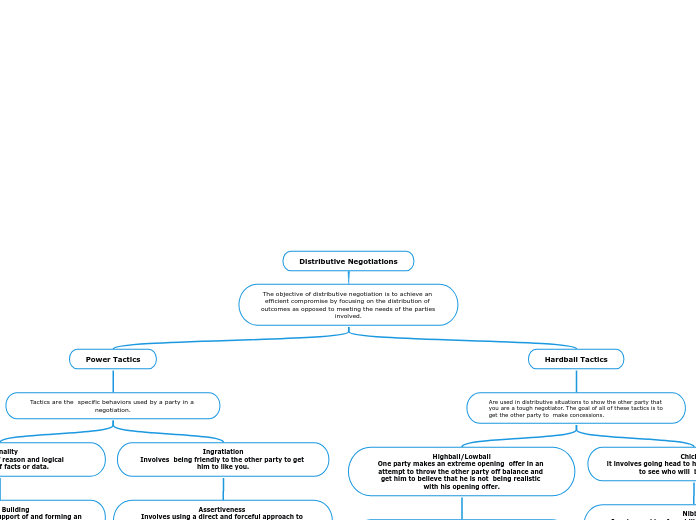Distributive Negotiations
The objective of distributive negotiation is to achieve an efficient compromise by focusing on the distribution of outcomes as opposed to meeting the needs of the parties involved.
Power Tactics
Tactics are the specific behaviors used by a party in a negotiation.
Rationality
Involves the use of reason and logical presentation of facts or data.
Coalition Building
Involves obtaining the support of and forming an alliance with others.
Upward appeal
Involves obtaining support for your position from people in higher positions of authority.
Ingratiation
Involves being friendly to the other party to get him to like you.
Assertiveness
Involves using a direct and forceful approach to push your own agenda and/or attack the other party’s position.
Imposing sanctions
Involves the use of coercive power to achieve the desired results.
Hardball Tactics
Are used in distributive situations to show the other party that you are a tough negotiator. The goal of all of these tactics is to get the other party to make concessions.
Highball/Lowball
One party makes an extreme opening offer in an attempt to throw the other party off balance and get him to believe that he is not being realistic with his opening offer.
Intimidation
May involve name-dropping to imply a closer relationship with those in power or settlement
Blizzard
It involves providing the other party with so much information that he is left feeling distracted
Chicken
it involves going head to head with the other party to see who will back down first.
Nibble
Involves asking for additional small things after negotiation has begun or even reached tentative agreement on the main issues.
Good Cop/Bad Cop
It begins with one officer taking the role of the hardnosed, “bad cop” who is very tough on the suspect, The other officer follows in the role of the “good cop” who in contrast appears reasonable so that the suspect wants to cooperate with him.
Claim Value
Negotiators use their power and sometimes hardball tactics to claim value, in other words, to get as much of the settlement range as possible. Claiming as much value as possible is the goal of distributive negotiation.
Concessions
Are what you give up and are expected in any negotiation.
Commitment
The final step in any negotiation is obtaining commitment from the parties on all issues involved in the negotiation.
Impasse
Generally when negotiating, the parties start with their opening offers and then make a series of concessions. In a perfect world this give and take continues until the parties reach agreement. If it doesn’t, the parties are said to come to impasse.
